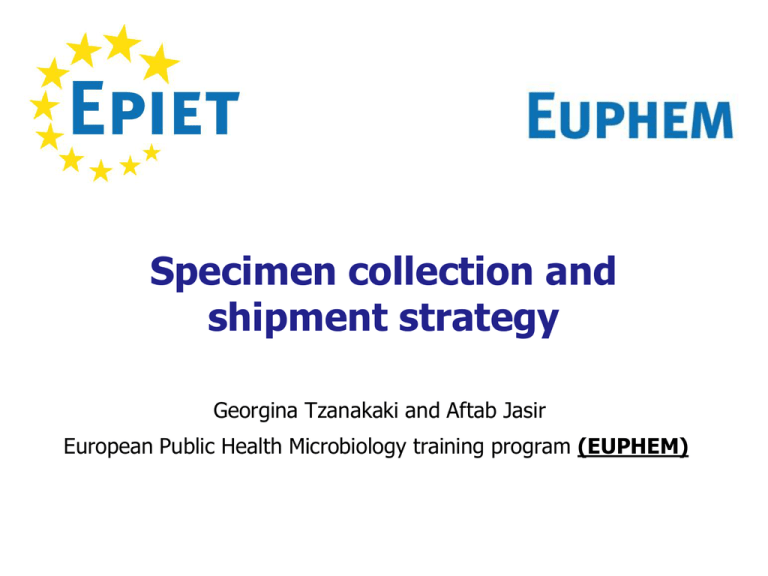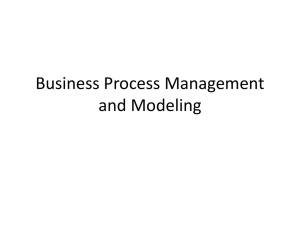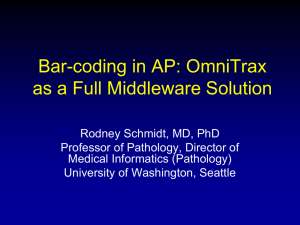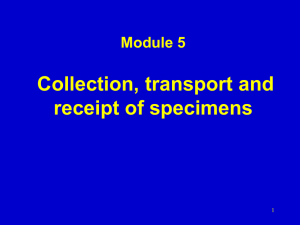
Specimen collection and
shipment strategy
Georgina Tzanakaki and Aftab Jasir
European Public Health Microbiology training program (EUPHEM)
• Why collection of specimens is
important?
• Why transportation is important?
Learning objective
At the end of this part of the presentation, you should be
able to understand the:
Procedures, preparation, processing and transport of
specimens
3
Procedures
• Collecting specimens
• Marking and labeling
• Handling
• Packing
• Package labeling
• Necessary documents following the
transporting sample
Procedures
• Collecting specimens
• Marking and labeling
• Handling
• Packing
• Package labeling
• Necessary documents following the
transporting sample
Specimen collection: key issues
Consider differential diagnoses
Decide on test(s) to be conducted
Decide on specimen/s to be collected to conduct
these tests
consultation between microbiologist,
clinicians and epidemiologist
6
The result of any laboratory examination is
only as good as the sample received in the
laboratory
7
Influences the
accuracy of
laboratory
diagnosis
Sample
Influences
laboratory
efficiency
Good
Management
sample
Influences
therapeutic
decisions
management
PH events
Outbreaks
Surveillance
Complex Emergency
situations
affects
patient care
and outcome
8
Procedures
• Collecting specimens
• Marking and labeling
• Handling
• Packing
• Package labeling
• Necessary documents following the
transporting sample
Labeling specimens
1. Name (unique identifier)
2. Clinical specimen
3. Specimen type
4. Date, time and place of collection
5. Name/initials of the person responsible
for collection
10
Criteria for rejecting samples
Mismatch of information on the label and the
request
Inappropriate transport temperature
Excessive delay in transportation
Inappropriate transport medium
- specimen received in a fixative
- dry specimen
- sample with questionable relevance
Insufficient quantity
Leakage
11
Case investigation form
Clinicians/test requester send:
Personal information
– age (or date of birth), sex, complete address
Clinical information
– date of onset of symptoms, clinical and immunization history, risk
factors or contact history where relevant, anti-microbial drugs taken
prior to specimen collection
Laboratory information
– acute or convalescent specimen
– other specimens from the same patient
Line listing – if large number of patients
12
13
Procedures
• Collecting specimens
• Marking and labeling
• Handling
• Packing
• Package labeling
• Necessary documents following the
transporting sample
Biosafety Principles
To protect:
– the patient
– yourself
– the environment -------(FILM)
15
Biosafety: protect the people
Use single use equipment
Disinfect
Work in a clean, dedicated area
16
Biosafety: protect yourself
Use personal protective equipment (PPE):
disposable gloves
laboratory coats / gown
mask
protective eyewear
17
Biosafety: protect yourself
Collect sharps immediately to prevent
needle-stick injury
Have first aid kit readily accessible
Do not reuse contaminated equipment
18
Biosafety:
protect others, the environment
• Package samples appropriately for transport
• Decontaminate spills
• Disinfect working areas for future use
• Soak contaminated non-disposable material
• Place waste in leak-proof biohazard bags
• Ensure safe final management of waste
• Protect cleaning personnel with PPE
19
Sample Handling
Handle all samples as if infectious
20
Procedures
• Collecting specimens
• Marking and labeling
• Handling
• Packing
• Package labeling
• Necessary documents following the
transporting sample
Transport Regulations
Where do they come from?
Who develops them?
United Nations Economic and Social Council
National transport regulations
ICAO/IATA transport regulations
rail, road, and sea traffic agencies
postal services
private couriers
22
Dangerous Goods Classes
Class 2: Non-flammable non-toxic gases
Liquid nitrogen (refrigeration)
Class 3: Flammable liquids
Ethanol (preservation)
Class 6: Toxic and infectious substances
Division 6.1 addresses toxic substances
Division 6.2 addresses infectious substances
Class 9: Miscellaneous dangerous goods
Dry ice
Genetically modified microorganisms and organisms (not classified
under 6.2)
Dangerous Goods Classes
Class 2: Non-flammable non-toxic gases
Liquid nitrogen (refrigeration)
Class 3: Flammable liquids
Ethanol (preservation)
Class 6: Toxic and infectious substances
Division 6.1 addresses toxic substances
Division 6.2 addresses infectious substances
Class 9: Miscellaneous dangerous goods
Dry ice
Genetically modified microorganisms and organisms (not classified under 6.2)
Substance Categories (Division 6.2)
Category A (Infectious Substances)
–
e.g. Ebola virus, Bacillus anthracis (culture only)
Category B (Biological Substances)
–
e.g.Bacillus anthracis (patient specimen), Highly pathogenic avian influenza virus
(patient specimen)
Exempt
–
Medical assessment has determined a minimal likelihood that pathogens are present
–
e.g. Pregnancy test, Drug screening
Category A: Infectious substances
An infectious substance which is transported in a
form that, when exposure to it occurs, is capable
of :
• causing permanent disability,
• life-threatening or
• fatal disease in otherwise healthy humans or
animals.
Category B – Biological Substances
• An infectious substance which does not
meet the criteria for inclusion in Category
A and has not been determined by a
medical professional to have a minimal
likelihood that pathogens are present.
e.g. serum, CSF, blood etc
Exempt
– Medical assessment has determined a
minimal likelihood that pathogens are
present
e.g. Pregnancy test, Drug screening
What is the difference
between cultures
and patient specimens?
Cultures and Patient Specimens
Cultures are incubated samples
(with purpose of
multiplying pathogens)
Patient specimens are collected directly from
humans/animals
These differences are important for the
classification of infectious substances
This classification will affect the choice of
packaging
Categorization and Identification
Categorization
Proper
Shipping Name
Category B
Biological
Substance,
Category B
Category A
Infectious
Substance,
Affecting
Humans
The Ebola virus has been
found in bats and
samples which have not
been cultured are being
shipped.
Category A
Infectious
Substance,
Affecting
Humans
Medical professional
declares human drug test
as minimal likelihood for
containing pathogens.
Exempt
Exempt
Human
Specimen
Situation
Patient presents with
suspected case of
Hepatitis B virus and
blood samples are sent.
Sending a culture of
Mycobacterium
tuberculosis to a reference
laboratory.
2009
World Health
Organization
What are the requirements for
packaging Category A and B
substances?
Triple Packaging
Triple packaging provides three layers of containment to
protect the substances being shipped. These layers are
primary, secondary, and outer containers.
The following diagram shows the basic concept of triple
packages.
Primary container
Absorbent and
cushioning
material
Secondary container
Outer container
Procedures
• Collecting specimens
• Marking and labeling
• Handling
• Packing
• Labeling packages
• Necessary documents following the
transporting sample
Markings and Labels
Infectious
Substance
Label
Markings and Labels
Orientation Labels
Mandatory on opposite sides when
primary container exceeds 50 ml
Markings and Labels
Shipper’s and
Receiver's Address
Markings and Labels
Emergency Contact
Name and Number
(Cat A)
Markings and Labels
Proper Shipping
Name and UN
Number
Markings and Labels
UN Specification
Marking (Cat A)
Markings and Labels
Procedures
• Collecting specimens
• Marking and labeling
• Handling
• Packing
• Package labeling
• Necessary documents following the
transporting sample
Documentation for Shipping
Infectious Substances
Overview
Air Waybill : goes with any shipment made by air
shipper or courier must complete the form
Completing the Shipper’s Declaration for Dangerous
Goods
Take home messages
For a good sample management and thus a good
laboratory diagnosis you need to:
Follow carefully sample collection information
Label samples with all necessary information
Respect biosafety principles to protect the patient, yourself
and the environment
Handle all samples as if infectious
Use appropriate packaging according to the category of
sample
Respect norms and regulations for transport
45
Sources
This presentation used some information of the training package
„Laboratory issues for epidemiologists“ put in place by the:
Department of Epidemic and Pandemic Alert and Response of
the World Health Organization
European Program for Public Health Microbiology (EUPHEM)
46
Thank you for your attention
?
47






